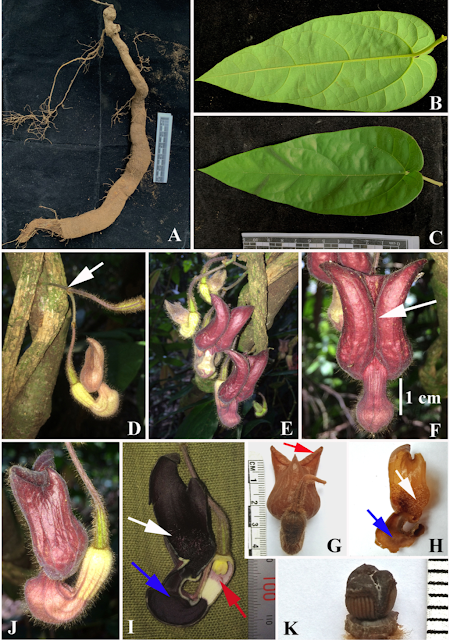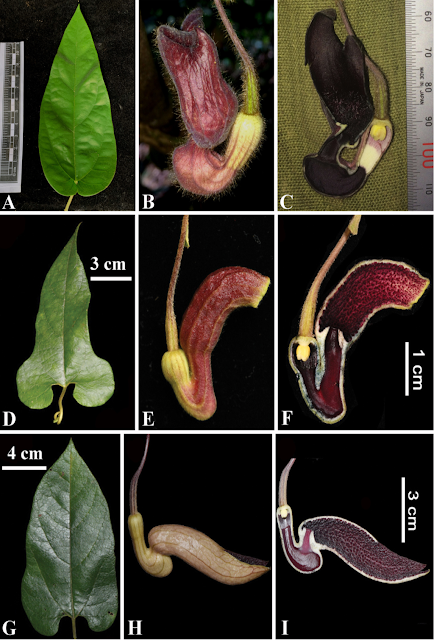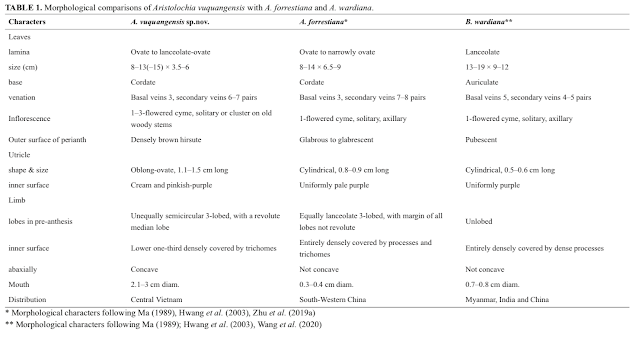Phytotaxa 500 (1): 037–044 https://www.mapress.com/j/pt/ Copyright © 2021 Magnolia Press
ISSN 1179-3155 (print edition) Article
https://doi.org/10.11646/phytotaxa.500.1.5
PHYTOTAXA
Aristolochia vuquangensis (Aristolochiaceae), a new species from Central Vietnam
TRUONG VAN DO1,2,5*, HUNG VIET NGUYEN3,6 & KHUONG DUY LE4,7
1 Vietnam National Museum of Nature, Vietnam Academy of Science & Technology, 18thHoang Quoc Viet Road, Cau Giay, Hanoi, Vietnam
2 Graduate University of Science and Technology, Vietnam Academy of Science & Technology, 18th Hoang Quoc Viet Road, Cau Giay, Hanoi, Vietnam
3 Vu Quang National Park, Vu Quang town, Ha Tinh province, Vietnam
4 Centre for Research on Ha Long Bay, Faculty of Environment, Ha Long University, 258th Bach Dang, Uong Bi, Quang Ninh, Vietnam
5 dovantruong_bttn@yahoo.com; https://orcid.org/0000-0002-0585-5513
6 viethung09122208@gmail.com; https://orcid.org/0000-0003-1659-6059
7 leduykhuong@daihochalong.edu.vn; https://orcid.org/0000-0003-1636-8750
* Author for correspondence
Abstract
Aristolochia vuquangensis (Aristolochia subgenus Siphisia), a new species from Central Vietnam, is described and illustrated here. This species is most similar to A. wardiana and A. forrestiana by sharing an ovate to lanceolate-ovate leaf blade and a cylindric or saccate-shaped limb, but it differs principally from the two species in having a densely brown hirsute outer surface of perianth, an oblong-ovate utricle, 1.1–1.5 cm long, an unequally semicircular 3-lobed limb in pre-anthesis, with a revolute median lobe, larger than two lateral lobes, abaxially concave, and lower one-third of the inner surface of limb densely covered by trichomes. A detailed description, illustrations, information on ecology, conservation status, and comparison with two similar species are also provided.
Keywords:
Aristolochiaceae, Flora of Vietnam, Piperales, Siphisia
Introduction
Aristolochia Linnaeus (1753: 960) sensu lato is the largest genus of the family Aristolochiaceae. It comprises about 600 species widely distributed throughout the tropics, subtropics, and temperate regions (Huber 1993, González & Stevenson 2002, Hwang et al. 2003, Wanke et al. 2006, González et al. 2014). Phylogenetic analyses based on morphological and molecular data strongly support a subdivision of the genus into three subgenera, viz. subgenus Aristolochia, subgenus Siphisia (Duch. 1854: 29) Schmidt (1935: 236), and subgenus Pararistolochia (Hutch. & Dalziel 1927: 75) Schmidt (1935: 241) (Duchartre 1854, 1864, Schmidt 1935, Ma 1989, González & Stevenson 2000, Wanke et al. 2006). Currently, 25 species of Aristolochia are known from Vietnam, 17 of which belong to subgenus Siphisia, and eight to subgenus Aristolochia (Do et al. 2015, 2016, 2017, 2019, Lai et al. 2019). Of these, ten species of subgenus Siphisia and two species of subgenus Aristolochia are endemic to Vietnam.
During a recent investigation on the flora of Vu Quang National Park, Ha Tinh province, Central Vietnam, we collected some interesting Aristolochia specimens that have a strongly curved or horseshoe-shaped perianth tube, a 3- lobed limb, and a 3-lobed gynostemium. These characters, especially the 3-lobed gynostemium, support its placement into the subgenus Siphisia (Do et al. 2015). Flowers of these new collections are characterized by a cylindric or saccate-shaped limb with three unequally semicircular lobes in pre-anthesis, in which the median lobe is larger than the two lateral lobes, revolute at margin, and abaxially concave. These features are clearly distinct from all previously described Siphisia species with a cylindric or saccate-shaped limb from tropical and temperate Asia (Ma 1989, Hwang et al. 2003, Do et al. 2015, Zhu et al. 2018, 2019a, 2019b, Wang et al. 2020). Therefore, we proceed to describe these specimens as a new species of Aristolochia subgenus Siphisia.
Material & methods
The studied specimens, collected in the Vu Quang National Park, Central Vietnam, were deposited in the herbarium of the Vietnam National Museum of Nature (VNMN), Vietnam Academy of Science and Technology.
Floral traits related to the shape, the color, the indumentum of the perianth, and the gynostemium were observed, measured, and photographed on both living plants and the dried specimens by using a Stemi DV4 LEICA S8 AP0 optical microscope (Wetzlar, Germany) and recorded under a Canon EOS 3000D (Japan) digital camera. The morphological characters were compared with descriptions in the protologue, type material and additional specimens of Aristolochia subgenus Siphisia species with cylindric or saccate-shaped limb available at the following herbaria: HITBC, HN, HNU, IBK, IBSC, KUN, PE, and VNMN (herbarium acronyms according to Thiers, 2020, continuously updated). Furthermore, relevant literature (Ma 1989, Hwang et al. 2003, Do et al. 2015, Zhu et al. 2018, 2019a, Wang et al. 2020) was also reviewed.
The description of the new species follows the terminology used by Harris & Harris (2001), Hwang et al. (2003), and Do et al. (2015). Assessment of the conservation status of the new species is according to current categories and criteria of IUCN (2012, 2019).
Taxonomic treatment
Aristolochia vuquangensis T.V.Do, sp. nov. (Fig. 1 & Fig. 2A-C)
The new species is most similar to A. wardiana J.S.Ma (1989: 348) and A. forrestiana J.S.Ma (1989: 321) by sharing an ovate to lanceolate-ovate leaf blade and a cylindric or saccate-shaped limb, but it differs principally from the two species in its densely brown hirsute outer surface of perianth (vs. pubescent in A. wardiana and glabrous to glabrescent in A. forrestiana), oblong-ovate utricle, 1.1–1.5 cm long (vs. cylindric, 0.5–0.6 cm long in A. wardiana and cylindric, 0.8–0.9 cm long in A. forrestiana), unequally semicircular 3-lobed limb in pre-anthesis with a revolute median lobe (vs. unlobed in A. wardiana and equally lanceolate 3-lobed limb with margin of all lobes not revolute in A. forrestiana), abaxially the median lobe of limb concave (vs. not concave in both A. wardiana and A. forrestiana), lower one-third of the inner surface of limb densely covered by trichomes (vs. entirely the inner surface of limb densely covered by processes in A. wardiana and densely covered by both processes and trichomes in A. forrestiana).
Type:
—VIETNAM. Ha Tinh province: Vu Quang district, Vu Quang National Park, elev. 1103 m, 18°15.133’N, 105°25.657’E, 30 August 2020, Do Van Truong DVT379 (holotype VNMN, isotypes HN, VNMN)
Perennial woody lianas, with oblong underground organs, 30–45 cm long, 3–5 cm in diam. Stem terete, young branches slender, zigzag, pubescent, turning to shallowly furrowed corky bark when mature, internodes 5–8 cm long. Petiole 2.2–2.7 cm long, slender, straight, pubescent. Leaf blade ovate to lanceolate-ovate, 8–13(–15) cm long, 3.5–6 cm wide, papery, base deeply cordate, sinus 6–7 cm deep, 3–5(–6) cm wide, apex acute, the adaxial surface dark green and glabrous, the abaxial surface puberulous, basal veins three, exceeding one-third the leaf length, secondary veins pinnate, six to seven pairs, venation reticulate, prominent on the abaxial surface, flattened on the adaxial surface, margin entire (Fig. 1B-C). Inflorescences cymose, 1–3-flowered, flowers clearly separated from each other, cymes on old woody stems, solitary or in a cluster of 3–4 (Fig. 1D-E). Inflorescence axis 1.5–2.2 cm long, straight, densely brown villous. Bracteoles clasping, subulate, 1.5–2 mm long, 1–1.5 mm wide, sessile, both sides densely brown pubescent, caducous (Fig. 1D). Pedicel 2–2.2 cm long, straight, densely brown pubescent. Ovary 1–1.5 cm long, 0.3–0.4 cm in diam., densely brown hirsute. Perianth strongly curved or horseshoe-shaped in lateral view, 3.5–4.2 cm high, greenish- yellow to yellowish-brown, purple, outer surface densely brown hirsute. Utricle distinct from the tube, oblong-ovate, inflated, 1.1–1.5 cm long, 0.7–0.9 cm in diam., upper half of inner surface cream, lower half of inner surface pinkish- purple, and densely covered by trichomes (Fig. 1J–I). Lower part of tube horseshoe-shaped, constricted at its base, 4–5 mm diam., gradually inflated, 9–13 mm in diam., and upper part of tube cylindrically-shaped, much narrower than the lower part, 6–9 mm long, 4–6 mm in diam., inner surface of both parts dark-purple and smooth (Fig. 1J-I). Limb with three unequally semicircular lobes in pre-anthesis, the two lateral (upper) lobes smaller than the median (lower) lobe, 1.6–1.8 cm wide, 0.5–0.6 cm high, margin of all lobes somewhat curved, the median lobe 2.7–3 cm wide, 1.1–1.4 cm high, margin revolute and abaxially concave in ventral view, during anthesis forming a cylindric or saccate-shaped limb, 2.5–3.8 cm long, 1.5–2.1 cm diam., slightly constricted at apex, 1.2–1.7 cm diam., with erect margins, outer surface reddish-purple, inner surface dark-purple, with lower one-third densely covered by trichomes, and upper two- third smooth (Fig. 1D-H). Annulus present, dark-purple, 4–5 mm diam. Mouth 2.1–3 cm diam. Gynostemium 3-lobed, cylindrical, pale yellow, 3.5–4 mm high, 4–5 mm in diam., lobes with acute apices (Fig. 1K). Anthers oblong, 2–2.5 mm long, 0.5 mm wide, yellow. Capsule unknown.
Etymology:
—The specific epithet refers to Vu Quang, a national park of Ha Tinh province, Central Vietnam, in which the new species was found.
Phenology:
—Flowering was observed from April to May. Fruiting unknown.
Distribution and ecology:
—The new species is currently known from Vu Quang National Park, Central Vietnam, located on the Truong Son mountain range on the Vietnam-Laos borderline. The new species grows on the humid and moist soils in subtropical broad-leaved evergreen forests, at elevations of ca. 1100 m, together with the dominant plants of Annonaceae (Fissigtima sp.), Celastraceae (Euonymus nitidus Benth. (1842: 483)), Ebenaceae (Diospyros sp.), Gesneriaceae (Rhaphiocarpus asper (Drake 1890: 127) B.L.Burtt (1997: 172)), Melastomataceae (Kerriothyrsus tetrandrus (Nayar 1970: 42) C.Hansen (1998: 154)), Primulaceae (Ardisia sp.), Rubiaceae (Lasianthus sp.), and Sapotaceae (Eberhardtia tonkinensis Lecomte (1920: 346)).
Conservation status:
—Only one very small-sized population of A. vuquangensis was found in the restricted area (ca. 4 km2) of Vu Quang National Park’s core zone, Ha Tinh province, Central Vietnam. Its natural habitat is well protected, but very few seedlings were recorded surrounding the mother plants or nearby. Furthermore, Vu Quang National Park is located on the eastern margin of the Vietnam-Laos borderline, where the weather in summers is hot and dry due to westerly winds and has been strongly affected by climate changes in recent years. Changes in precipitation and temperature across this area can shift, fragment, contract, or increase species’ ranges, leading to changes in Extent of Occurrence (EOO) and Areas of Occupancy (AOO), and the degree of fragmentation. These changes also expose organisms to conditions outside their range of physical tolerance, resulting in reduced survival and fecundity, leading to reductions in population size (Deutsch et al. 2008). Thus, the persistence of the species might be at risk soon. The new species is preliminarily assessed as Critically Endangered (CR B2b, C1b, D) according to the IUCN category and criteria (IUCN 2012, 2019). However, the lack of sufficient data about its natural distribution currently does not allow a final risk evaluation, and the species might be regarded as Data Deficient (DD). Further field surveys in surrounding areas (including protected forest areas in Laos) are needed to gain more information on its distribution.
Notes:
—Aristolochia subgenus Siphisia, comprising 98 species and one subspecies, is distributed mainly in Southeast Asia and North and Central America (González et al. 2014, Do et al. 2015). Morphologically, the new species is quite similar to some species of Aristolochia subgenus Siphisia such as Aristolochia cucurbitoides C.F.Liang (1975: 15), A. forrestiana, A. melanocephala X.X.Zhu & J.S.Ma (2018: 298), A. ovatifolia S.M.Hwang (1981: 226), A. pseudoutriformis X.X.Zhu & J.S.Ma (2019b: 94), A. thwaitesii J.D.Hooker (1856: 4918), A. transeccta (Chatterjee 1948: 64) C.Y.Wu ex S.M.Hwang (1981: 231), A. utriformis S.M.Hwang (1981: 228), A. wardiana, A. yangii X.X.Zhu & J.S.Ma (2019b: 98), and one recently described isotrema species (i. brevilimbum X.X.Zhu, Jun Wang & F.Cao (2020: 16)) by sharing a cylindric or saccate-shaped limb. The new species is most similar to A. forrestiana and A. wardiana by having an ovate to lanceolate-ovate leaf blade and a brown to reddish-purple, oblong-cylindric limb. However, it is easily distinguished from these two species by the combination of some morphological characters such as inflorescence, indumentum of perianth, shape and size of utricle, limb lobes, and indumentum of the inner surface of limb lobes. Detailed comparisons of the new species and its two similar species are shown in Table 1 and Figure 2.
Acknowledgments
We are very grateful to Mr. Nguyen Danh Ky, the director and the staff of the Vu Quang National Park, Ha Tinh province, Vietnam, for collecting permission and organization of fieldwork. Special thanks to Stephen Maciejewski, The Gesneriad Society, and Michael LoFurno, Adjunct Professor, Temple University, Philadelphia PA, the USA, for their editorial assistance. The Vietnam Academy of Science and Technology financially supported this research work under the project code ĐLTE 00.09/21-22.
References
Deutsch, C.A., Tewksbury, J.J., Huey, R.B., Sheldon, K.S., Ghalambor, C.K., Haak, D.C. & Martin, P.R. (2008) Impacts of climate warming on terrestrial ectotherms across latitude. PNAS 105 (18): 6668–6672. https://doi.org/10.1073/pnas.0709472105
Do, T.V., Luu, T.H., Wanke, S. & Neinhuis, C. (2015) Three new species and three new records of Aristolochia subgenus Siphisia from Vietnam, including a key to the Asian species. Systematic Botany 40: 671–691. https://doi.org/10.1600/036364415X689140
Do, T.V., Truong, C.Q. & Huynh, H.T.T. (2017) Aristolochia neinhuisii (Aristolochiaceae), a new species from Vietnam. Annales Botanici Fennici 54: 203–208. https://doi.org/10.5735/085.054.0602
Do, T.V., Vu, T.T.H., Luu, H.T. & Nguyen, T.T. (2019) Aristolochia nuichuaensis (subgus Siphisia, Aristolochiaceae), a new species, an updated key and a checklist to the species of Siphisia in Vietnam. Annales Botanici Fennici 56: 107–113. https://doi.org/10.5735/085.056.0116
Do, T.V., Wanke, S. & Neinhuis, C. (2016) Aristolochia bidoupensis sp. nov. from southern Vietnam. Nordic Journal of Botany 34: 513–516. https://doi.org/10.1111/njb.01066
Duchartre, P. (1854) Tentamen methodicae divisionis generis Aristolochia, additis descriptionibus complurium novarum specierum novique generis Holostylis. Annales des Sciences Naturelles, 4a. Sér. 2: 29–76.
Duchartre, P. (1864) Aristolochiaceae. in: Candolle, A.P.de (Ed.) Prodromus systematis naturalis regni vegetabilis, vol. 15. Masson, Paris, pp. 421–498. https://doi.org/10.5735/085.054.0602
González, F. & Stevenson, D.W. (2002) A phylogenetic analysis of the subfamily Aristolochioideae (Aristolochiaceae). Revista de la Academia Colombiana de Ciencias Exactas 26: 25–60.
González, F., Wagner, S.T., Salomo, K., Samain, M.S., Isnard, S., Rowe, N.K., Neinhuis, C. & Wanke, S. (2014) Present trans-Pacific disjunct distribution of Aristolochia subgenus isotrema (Aristolochiaceae) was shaped by dispersal, vicariance, and extinction. Journal of Biogeography 41: 380–391. https://doi.org/10.1111/jbi.12198
Harris, J.G. & Harris, M.W. (2001) Plant identification Terminology: An illustrated Glossary (2nd). Spring Lake Pub., Spring Lake, Utah, 216 pp.
Hooker, W.J. (1856) Curtis’s Botanical Magazine, comprising the plants of the Royal Gardens of Kew and other botanical establishments in Great Britain, with suitable description, vol. 82: Tab., 4918.
Huber, H. (1993) Aristolochiaceae. in: Kubitzki, K., Rohwer, J.G. & Bittrich, V. (Eds.) The families and genera of vascular plants. Springer, Berlin, pp. 129–137. https://doi.org/10.1007/978-3-662-02899-5_10
Hutchinson, J. & Dalziel, J.M. (1927) Aristolochiaceae. in: Hutchinson, J. & Dalziel, J.M. (Eds.) Flora of west tropical Africa, vol. 1. Crown Agents for the Colonies, London, pp. 75–78.
Hwang, S.M. (1981) Materials for Chinese Aristolochia. Acta Phytotaxonomica Sinica 19: 222–231. [in Chinese]
Hwang, S.M., Kelly, L.M. & Gilbert, M.G. (2003) Aristolochia Linnaeus. in: Wu, Z.Y., Raven, P.H. & Hong, D.Y. (Eds.) Flora of China 5. Science Press, Beijing & Missouri Botanical Garden Press, St. Louis, pp. 258–269.
IUCN (2012) iUCN Red List Categories and Criteria, Version 3.1 (2ndEd.) Gland and Cambridge, 32 pp.
IUCN Standards and Petitions Subcommittee (2019) Guidelines for Using the iUCN Red List Categories and Criteria, Version 14. Prepared by the Standards and Petitions Subcommittee. Available from: https://www.iucnredlist.org/resources/redlistguidelines (accessed 28 December 2020)
Lai, V.H., Nguyen, T.T., Phan, V.D., Prilepsky, N.G., Nuraliev, M.S. & Do, T.V. (2019) Aristolochia binhthuanensis, a new species and a key to the species of A. subgenus Aristolochia in Vietnam. Annales Botanici Fennici 56: 241–246. https://doi.org/10.5735/085.056.0408
Liang, C.F. (1975) The Aristolochiaceae of Kwangsi Flora. Acta Phytotaxonomica Sinica 13 (2): 10–28. [in Chinese] Linnaeus, C. von (1753) Species Plantarum 2. Impensis Laurentii Salvii, Holmiae [Stockholm], pp. 561–1200. https://doi.org/10.5962/bhl.title.669
Ma, J.S. (1989) A revision of Aristolochia Linn. from E. & S. Asia. Acta Phytotaxonomica Sinica 27: 321–364. [in Chinese]
Rafinesque, C.S. (1819) Art. 3. The genera of North-American plants: and a catalog of the species to the year. By Thomas Nuttall, F.L.S. & o. & c. two vols. 12mo. Philadelphia 1818. American Monthly Magazine and Critical Review 4: 184–196.
Schmidt, O.C. (1935) Aristolochiaceae. in: Engler, A. & Prantl, K. (Eds.) Die natürlichen Pflanzenfamilien, vol. 2,16B. Engelmann, Leipzig, pp. 204–242.
Thiers, B.M. (2020, continuously updated) index Herbariorum: A global directory of public herbaria and associated staff. New York Botanical Garden’s Virtual Herbarium. Available from: http://sweetgum.nybg.org/science/ih/ (accessed 28 December 2020)
Wang, J., Ya, J.D., Liu, C., Liu, G., Cao, F., Ma, J.S. & Zhu, X.X. (2020) Taxonomic studies on the genus isotrema (Aristolochiaceae) from China: II. i. brevilimbum (Aristolochiaceae), a new species from Guizhou, China. PhytoKeys 152: 15–25. https://doi.org/10.3897/phytokeys.152.51760
Wanke, S., González, F. & Neinhuis, C. (2006) Systematics of pipevines: Combining morphological and fast-evolving molecular characters to investigate the relationships within subfamily Aristolochioideae (Aristolochiaceae). international Journal of Plant Sciences 167: 1215–1227. https://doi.org/10.1086/508024
Zhu, X.X., Li, X.Q., Liao, S., Li, G. & Ma, J. (2019a) The taxonomic revision of Asian Aristolochia (Aristolochiaceae) V: two new species from Yunnan, China. in: Cai, J., Yu, W.B., Zhang, T. & Li, D.Z. (Eds.) Revealing the plant diversity in China’s biodiversity hotspots. PhytoKeys 130: 93–106. https://doi.org/10.3897/phytokeys.130.33933
Zhu, X.X., Li, X.Q., Liao, S., Du, C., Wang, Y., Wang, Z.H., Yan, J., Zuo, Y.J. & Ma, J.S. (2019b) Reinstatement of isotrema, a new generic delimitation of Aristolochia subgenus Siphisia (Aristolochiaceae). Phytotaxa 401 (1): 1–23. https://doi.org/10.11646/phytotaxa.401.1.1
Zhu, X.X., Shen, B., Sun, Z.P., Chen, B., Liao, S. & Ma, J.S. (2018) Two New Species of Aristolochia (Aristolochiaceae) from Yunnan, China. Novon 26 (3): 298–306. https://doi.org/10.3417/2018066





0 Comment:
Post a Comment